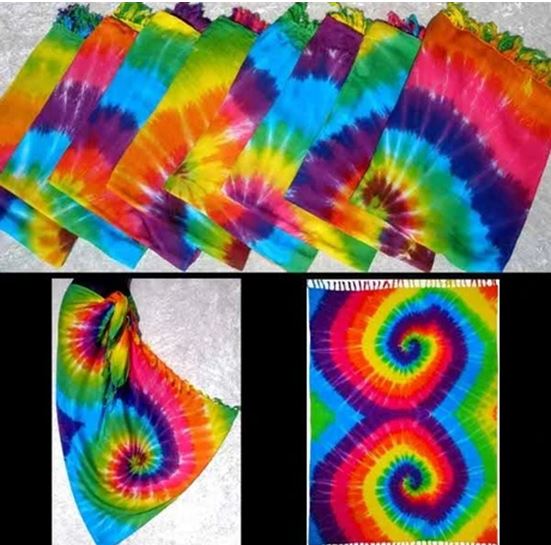Since time immemorial, tie-dye has been an activity that was used to entertain kids and adults alike – bond, get their hands dirty, test out their creative skills, enjoy the process of being a creator. More recently, though times have changed, but this process hasn’t changed. Almost everybody has, at some point in their lives, tried a tie-dyeing process. It is not just for pieces of clothing in one’s wardrobe but can also be adapted into mainstream household goods such as – bedsheets, curtains, pillow covers, comforters, quilts, fabric sofas, etc.

History of Tie-Dye
Historically, the tie-dyeing process dates back to around 500 – 800 BC. Peru was one of the first countries that exhibited their tie-dyeing designs in everyday life. The designs were mostly – circles and lines made in various primary colors, red, yellow, green, and blue. As time went by, these simplistic designs evolved into spirals, ovals, diamonds, marbles, squares and knots.
Later individuals began to incorporate beads, shells, and various other forms of ornamentation in their tie-dyes, these techniques got picked up pretty quickly around the world, and almost all regions had their version of tie-dye. Bandhani style originates in India, The Shibori tie-dye technique is famous in the Japanese culture, and coastal countries in SouthEast Asia, such as Laos and Thailand, came up with the Mudmee style tie-dye. It has been suggested that African dying techniques may have been the origin of tie-dye associated with “hippie” culture. Tie-Dye clothing is often an the unofficial clothing of spring festivals and music festivals across the world. Tie-dye is considered hip, jazzy, and fun in almost all these cultures and has even seeped quietly into the mainstream fast-fashion brands seasonal roll out of clothing. Forever 21 is one of the biggest producers of Tie-Dye clothing.
In the early days, dyes were extracted from roots, leaves, berries, and even flowers of various kinds. If you look through YouTube, even today, there are Chinese bloggers who use flowers and berries to demonstrate how they are extracted, and then they make clothing designs out of these dyes.
After using these kinds of homemade dyes, the mass production of synthetic dyes came into play, and the market was flooded with mass-produced tie-dye products. Wholesale rainbow clothing is now available and the spiral is one of the most popular tie-dye color designs.
Tie-Dye in Today’s World
Tie-dye is still considered popular in hippie culture, but it has also become a vital part of the current fashion world as well. Even top designers today use these tie-dye techniques in their yearly collections, mostly during the summer and spring seasons. There is no limit to designs that can be used to make tie-dye material.
Not only is tie-dye used as a part of upper body clothing but has also diversified into being part of the lower body clothing such as sarongs, pants, socks, stockings, etc. One of the most significant advantages of this style of clothing and technique is that they are gender-neutral and fluid. They aren’t specifically for females or males. Anyone who appreciates the design can use almost any tie-dye clothing, even wholesale rainbow clothing for schools, offices, and small celebratory gatherings like – beach parties, bar hopping, playdates, tie-dye themed birthday parties, etc.
These are just a few essential details about the advent of tie-dye materials, clothing, history, and the various styles that tie-dye is focused on today. Tie-dye is as relevant today as it was in 500 BC. Perhaps it is more relevant today than then. So, the next time you want to organize a gathering, give tie-dye a chance and embrace the uniqueness of this age-old process and fashion.







